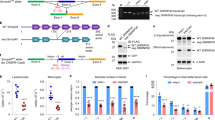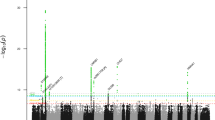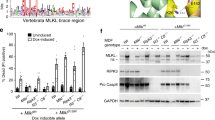Abstract
The gene that is abnormal in the X-linked form of the phagocytic disorder chronic granulomatous disease has been cloned without reference to a specific protein by relying on its chromosomal map position. The transcript of the gene is expressed in the phagocytic lineage of haematopoietic cells and is absent or structurally abnormal in four patients with the disorder. The nucleotide sequence of complementary DNA clones predicts a polypeptide of at least 468 amino acids with no homology to proteins described previously.
This is a preview of subscription content, access via your institution
Access options
Subscribe to this journal
Receive 51 print issues and online access
$199.00 per year
only $3.90 per issue
Buy this article
- Purchase on Springer Link
- Instant access to full article PDF
Prices may be subject to local taxes which are calculated during checkout
Similar content being viewed by others
References
Botstein, D., White, R. L., Skolnick, M. & Davis, R. W. Am. J. hum. Genet. 32, 314–331 (1980).
Davies, K. E. et al. Nucleic Acids Res. 11, 2303–2312 (1983).
Monaco, A. P. et al. Nature 316, 842–845 (1985).
Knowlton, R. G. et al. Nature 318, 380–382 (1985).
White, R. et al. Nature 318, 382–384 (1985).
Wainwright, B. J. et al. Nature 318, 384–385 (1985).
Gusella, J. F. et al. Nature 306, 234–238 (1983).
Collins, F. & Weissman, S. Proc. natn. Acad. Sci. U.S.A. 81, 6812–6818 (1984).
Tauber, A. I., Borregaard, N., Simons, E. & Wright, J. Medicine 62, 286–309 (1983).
Weening, R. S. et al. J. clin. Invest. 75, 915–920 (1985).
Segal, A. W. et al. New Engl. J. Med. 308, 245–251 (1983).
Markert, M., Glass, G. A. & Babior, B. M. Proc. natn. Acad. Sci. U.S.A. 82, 3144–3148 (1985).
Baehner, R.L. et al. Proc. natn. Acad. Sci. U.S.A. 83, 3398–3401 (1986).
Francke, U. et al. Am. J. hum. Genet. 37, 250–267 (1985).
Kunkel, L. M. et al. Proc. natn. Acad. Sci. U.S.A. 82, 4778–4782 (1985).
Coilins, S. J., Ruscetti, F. W., Gallagher, R. E. & Gallo, R. C. Proc. natn. Acad. Sci. U.S.A. 75, 2458–2462 (1978).
Newburger, P.E. et al. J. biol. Chem. 259, 3771–3776 (1984).
Young, R. A. & Davis, R. W. Proc. natn. Acad. Sci. U.S.A. 80, 1194–1198 (1983).
Gubler, U. & Hoffman, B. J. Gene 25, 263–279 (1983).
Ginsburg, D. et al. Science 228, 1401–1406 (1985).
Rovera, G., Santoli, D. & Damsky, C. Proc. natn. Acad. Sci. U.S.A. 76, 2779–2783 (1979).
Volkman, D. J., Buescher, E. S., Gallin, J. I. & Fauci, A. S. J. Immun. 133, 3006–3009 (1984).
Melton, D. A. et al. Nucleic Acids Res. 12, 7035–7056 (1984).
Messing, J. Meth. Enzym. 101, 20–78 (1983).
Dale, R. M. K., McClure, B. A. & Houchins, J. P. Plasmid 13, 31–40 (1985).
Kozak, M. Nucleic Acids Res. 12, 857–872 (1984).
Proudfoot, N. J. & Brownless, G. G. Nature 263, 211–214 (1976).
Nishioka, Y., Leder, A. & Leder, P. Proc. natn. Acad. Sci. U.S.A. 77, 2806–2809 (1980).
Sharp, P. A. Nature 301, 471–472 (1983).
Harper, A. M., Chaplin, M. F. & Segal, A. W. Biochem. J. 227, 783–788 (1985).
Segal, A. W. Lancet i, 1378–1382 (1985).
Davis, M. Proc. natn. Acad. Sci. U.S.A. 81, 2194–2198 (1984).
Southern, E. M. J. molec. Biol. 98, 503–517 (1975).
Michelson, A. M., Markham, A. F. & Orkin, S. H. Proc. natn. Acad. Sci. U.S.A. 80, 472–476 (1983).
Chirwin, J. M., Przygyla, A. E., MacDonald, R. J. & Rutter, W. J. Biochemistry 18, 5294–5298 (1979).
Maniatis, T., Fritsch, E. & Sambrook, J. Molecular Cloning: a Laboratory Manual (Cold Spring Harbor Laboratory, New York, 1982).
Feinberg, A. P. & Vogelstein, B. Analyt. Biochem. 132, 6–13 (1983).
Strunk, R. C., Whitehead, A. S. & Cole, F. S. J. clin. Invest. 76, 985–990 (1985).
Sanger, F., Nicklen, S. & Coulson, A. R. Proc. natn. Acad. Sci. U.S.A. 74, 5463–5467 (1977).
Maxam, A. M. & Gilbert, W. Meth. Enzym. 65, 499–580 (1980).
Treisman, R., Proudfoot, N. J., Shander, M. & Maniatis, T. Cell 29, 903–911 (1982).
Francke, U. CytoGenet. Cell Genet. 38, 298–307 (1984).
Author information
Authors and Affiliations
Rights and permissions
About this article
Cite this article
Royer-Pokora, B., Kunkel, L., Monaco, A. et al. Cloning the gene for an inherited human disorder—chronic granulomatous disease—on the basis of its chromosomal location. Nature 322, 32–38 (1986). https://doi.org/10.1038/322032a0
Received:
Accepted:
Issue Date:
DOI: https://doi.org/10.1038/322032a0
This article is cited by
-
Inborn errors of immunity: an expanding universe of disease and genetic architecture
Nature Reviews Genetics (2023)
-
Structure, regulation, and physiological functions of NADPH oxidase 5 (NOX5)
Journal of Physiology and Biochemistry (2023)
-
Seeing the forest through the trees: prioritising potentially functional interactions from Hi-C
Epigenetics & Chromatin (2021)
-
NADPH oxidases and oxidase crosstalk in cardiovascular diseases: novel therapeutic targets
Nature Reviews Cardiology (2020)
Comments
By submitting a comment you agree to abide by our Terms and Community Guidelines. If you find something abusive or that does not comply with our terms or guidelines please flag it as inappropriate.



